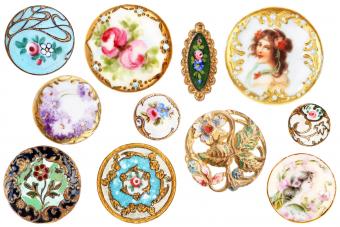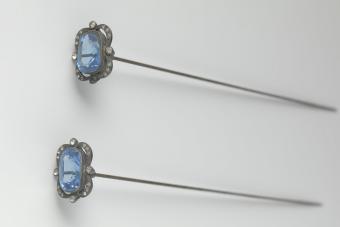
Knowing how to identify rare antique buttons can help you sort out valuable beauties. You often see old buttons sold by the jar, bucket, or even by the pound. Sorting through all of them can take some time, but it's easier if you know the signs a button is rare and potentially valuable. Learn the top signs that an antique button may be rare, as well as tricks to identify materials, time period, and more.
How to Identify an Antique Button
Strictly speaking, a button must be 100 years old to be considered antique. Vintage decorative buttons, made after about 1920, do have value, but antique buttons made before this period are the rarest. Here are some tricks to determine whether a button is very old:
- It shows signs of being handmade, such as a lack of uniformity.
- The button displays an antique style, such as Art Nouveau or Art Deco.
- The back of the button is not a uniform texture.
- There are no mold lines to indicate machine manufacturing.
Six Characteristics of Rare Antique Buttons
People have been using buttons to fasten clothing for centuries, but they are much more than utilitarian items. Rare buttons are also works of art. When a garment wore out and was destined for the rag bag, frugal housewives and maids often snipped off the beautiful buttons for use in other clothing. Because of this care, rare and beautiful buttons still exist today. Identifying one is mostly about knowing the characteristics that make it special. Most rare buttons will have a few of these traits.
Non-Plastic Materials
Technically, an antique button is unlikely to be made of plastic. There are a few exceptions, especially when it comes to an early plastic called celluloid. However, the rarest buttons were not mass-produced plastics like celluloid or Bakelite (another early plastic that is popular in vintage jewelry). Instead of plastic or Bakelite, rare antique buttons are often crafted from these materials:
- Porcelain or ceramic - This clinks when you tap it and feels cool and light.
- Mother of pearl and shell - These materials are often iridescent and show variation within the button.
- Wood - This will show a wood grain and feel lightweight.
- Metal - This may have stamped details and be wrapped around a base.
- Glass - Glass will clink when you gently tap it on a hard surface.
- Jet - This black natural material is lightweight and is often carved.
- Bone - Antler, ivory, and bone buttons show grain and subtle variation.
- Tortoiseshell - This lightweight material will show natural color variation in shades of brown and grey.
- Stone and gemstone - Most stone feels cool and heavy to the touch.
Precious Metals
Metal buttons can come in everything from steel or brass to silver and gold. However, the rarest and most valuable will be precious metals. You can find the metal content by flipping the button over and looking for hallmarks and maker's marks. Sterling silver buttons, for instance, will often bear the word "Sterling" or the number "925."

Hand Painted Details
Hand painting can make an antique button very special. In fact, a hand-painted button is one-of-a-kind, even if the design itself is not unique. Hand painting means the decoration was added by a person, so no two buttons are alike. Look for florals, country scenes, miniature portraits, pictures of animals, and more.

Figural Designs
A figural design is one that represents a person, animal, mystical creature, or other strong motif. These buttons look like something special. You'll see Art Nouveau designs featuring women with flowing hair, buttons made to look like fruit or flowers, or even entire pastoral scenes produced in miniature. Figural buttons are among the most collectible.

Hand Carving
Instead of being made by machine, many antique buttons are carved by hand. Even the most perfectly carved bone or shell button will have subtle signs of being carved by hand. You'll see little variations in the texture and depth of carving, as well as a slight lack of uniformity. When the carving is well done, these hand-carved buttons are valuable.
Micro Mosaic Art, Enamel, and Other Special Touches
Some rare buttons feature tiny mosaics made of pieces of stone or shell. Others are enamelled with colored glass fused to the surface as a decoration. Special touches like this make a button rare and unique, and some collectors specialize in buttons that display these specific techniques.

Are Antique Buttons Valuable?
Some antique buttons are valuable, but most sell for less than $50. However, if you suspect you have a rare antique button, it may be worth much more. Some rare examples go for hundreds or even thousands of dollars. You'll see buttons selling as sets and also individually.
Sample Values for Individual Rare Antique Buttons
Individual buttons that are especially rare sell in the hundreds of dollars. Here are a few beautiful examples:
- A hand-painted button from the Colonial era fetched almost $500 at auction in 2020. It features a painting of a woman holding a boat anchor.
- A figural enamel button in the shape of a peacock sold for about $400. It had very fine detailing and dated from the the early 1900s.
- Although it was made from brass and not a precious metal, a highly detailed figural metal button of a woman knitting sold for about $225.
Value of Button Sets and Collections
When antique buttons are included in a set or collection, they can sometimes be even more valueable. People have been collecting buttons for a long time, and the oldest collections can include rare and valuable buttons. These assembled sets can have value on their own, not just for the buttons included. For instance, a Victorian button book with hundreds of unique buttons sold for over $2,100 as a colleciton.
Collect Buttons You Love
If you're searching through your grandmother's button collection or pouring over the wares at a flea market, being able to identify rare buttons is a valuable skill. However, even if buttons aren't rare, they can be a fun an affordable antique to collect. Start by choosing buttons you like and work up from there. Soon, you'll have some beautiful examples you can display in your home, attach to clothing, or show off as charms in jewelry.







